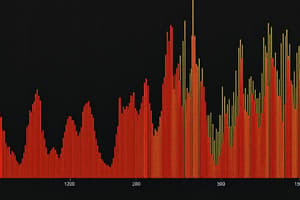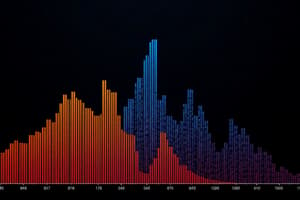Podcast
Questions and Answers
Which of the following is NOT a method of data presentation?
Which of the following is NOT a method of data presentation?
- Inferential analysis (correct)
- Summary indices
- Graphical presentation
- Tabular presentation
In a frequency table, what does 'CLASS FREQUENCY (CF)' represent?
In a frequency table, what does 'CLASS FREQUENCY (CF)' represent?
- The range of values within a class
- The total number of observations in the dataset
- The midpoint of a class interval
- The number of observations falling in a particular class (correct)
Which of the following is LEAST suited for summarizing nominal data?
Which of the following is LEAST suited for summarizing nominal data?
- Mean (correct)
- Frequency distribution
- Median
- Mode
What is the primary characteristic of measures of central tendency?
What is the primary characteristic of measures of central tendency?
Which measure of central tendency is most affected by extreme values?
Which measure of central tendency is most affected by extreme values?
For which type of variable is the mean a suitable measure?
For which type of variable is the mean a suitable measure?
What does the summation symbol '$\Sigma x$' represent in the context of calculating the mean?
What does the summation symbol '$\Sigma x$' represent in the context of calculating the mean?
What is the first step in calculating the median of a dataset?
What is the first step in calculating the median of a dataset?
When is the median a more appropriate measure of central tendency than the mean?
When is the median a more appropriate measure of central tendency than the mean?
Which of the following is a disadvantage of using the median as a measure of central tendency?
Which of the following is a disadvantage of using the median as a measure of central tendency?
What does the mode represent?
What does the mode represent?
Which type of data is the mode best suited for?
Which type of data is the mode best suited for?
What is a key advantage of using the mode?
What is a key advantage of using the mode?
What is the primary disadvantage of using the mode as a measure of central tendency?
What is the primary disadvantage of using the mode as a measure of central tendency?
How is the midrange calculated?
How is the midrange calculated?
Why is the midrange considered a less robust measure of central tendency?
Why is the midrange considered a less robust measure of central tendency?
What is the impact on the mode if several observations in a dataset share the same highest frequency?
What is the impact on the mode if several observations in a dataset share the same highest frequency?
Which measure of central tendency is generally preferred for statistical analyses and tests of significance and why?
Which measure of central tendency is generally preferred for statistical analyses and tests of significance and why?
What does it indicate if the mean is greater than the median in a dataset?
What does it indicate if the mean is greater than the median in a dataset?
In calculating the mean for grouped data, what does finding the 'class-mid mark' achieve?
In calculating the mean for grouped data, what does finding the 'class-mid mark' achieve?
How are class boundaries determined?
How are class boundaries determined?
Given the following dataset: 10, 12, 15, 18, 20. What is the midrange?
Given the following dataset: 10, 12, 15, 18, 20. What is the midrange?
In a positively skewed distribution, which of the following relationships between mean, median, and mode is typically observed?
In a positively skewed distribution, which of the following relationships between mean, median, and mode is typically observed?
Consider a dataset with the values: 2, 2, 3, 4, 5, 5, 5, 6. What is the mode?
Consider a dataset with the values: 2, 2, 3, 4, 5, 5, 5, 6. What is the mode?
What is the median of the following data set: 5, 8, 12, 3, 6?
What is the median of the following data set: 5, 8, 12, 3, 6?
Given a data set with extreme outliers, which measure of central tendency should be used?
Given a data set with extreme outliers, which measure of central tendency should be used?
What is the cumulative frequency?
What is the cumulative frequency?
In a data set, how do you calculate the range?
In a data set, how do you calculate the range?
CLASS RELATIVE FREQUENCY is also known as what?
CLASS RELATIVE FREQUENCY is also known as what?
For grouped data, what is the modal class?
For grouped data, what is the modal class?
Advantages of the Mean include which of the following?
Advantages of the Mean include which of the following?
What measure is the Median of grouped data?
What measure is the Median of grouped data?
Measures of central tendency do what?
Measures of central tendency do what?
Which is not a consideration for a Choice of a measure?
Which is not a consideration for a Choice of a measure?
What is the difference between class limits and class boundaries?
What is the difference between class limits and class boundaries?
Which of the following is most reliable?
Which of the following is most reliable?
Which of the following is most fashionable?
Which of the following is most fashionable?
A1 of the mode with the grouped data is
A1 of the mode with the grouped data is
What does bL mean in Median?
What does bL mean in Median?
Flashcards
Data grouping
Data grouping
Grouping or collating data into frequencies to determine the rate of occurrence.
Tabular Presentation
Tabular Presentation
Data presented in rows and columns.
Graphical Presentation
Graphical Presentation
Visual representation of data using charts and diagrams.
Histogram
Histogram
Signup and view all the flashcards
Frequency Polygon
Frequency Polygon
Signup and view all the flashcards
Bar chart
Bar chart
Signup and view all the flashcards
Pie Chart
Pie Chart
Signup and view all the flashcards
Summary Indices
Summary Indices
Signup and view all the flashcards
Class
Class
Signup and view all the flashcards
Class Frequency
Class Frequency
Signup and view all the flashcards
Measures of Location
Measures of Location
Signup and view all the flashcards
Measures of Dispersion
Measures of Dispersion
Signup and view all the flashcards
Measures of Partition
Measures of Partition
Signup and view all the flashcards
Central Tendency
Central Tendency
Signup and view all the flashcards
Mean
Mean
Signup and view all the flashcards
Suitable variable for mean.
Suitable variable for mean.
Signup and view all the flashcards
Calculating Mean
Calculating Mean
Signup and view all the flashcards
Mean properties
Mean properties
Signup and view all the flashcards
Mean disadvantage
Mean disadvantage
Signup and view all the flashcards
Median
Median
Signup and view all the flashcards
Median data types
Median data types
Signup and view all the flashcards
Median properties
Median properties
Signup and view all the flashcards
Lower Boundary
Lower Boundary
Signup and view all the flashcards
Median advantages
Median advantages
Signup and view all the flashcards
Mode
Mode
Signup and view all the flashcards
Modal Class
Modal Class
Signup and view all the flashcards
Mode advantages
Mode advantages
Signup and view all the flashcards
Mid-Range
Mid-Range
Signup and view all the flashcards
Choice of measures
Choice of measures
Signup and view all the flashcards
Study Notes
Data Presentation Methods
- Data is grouped or collated into frequencies to determine the rate of occurrence.
- Tabular presentation uses frequency tables
- Useful for both quantitative and qualitative data
- Graphical or diagrammatic presentation can use:
- Histograms or frequency polygons for quantitative or numerical data
- Bar or pie charts for qualitative or categorical data
- Dot maps for geographical mapping
- Summary indices include measures such as mean, median, and mode.
Tabular Presentation Definitions
- Class refers to one of the groups into which data can be classified
- Class Frequency (CF) is the number of observations (NOB) in the data set that falls into a particular class
Measures of Summarizing Data
- Measures of location or central tendency summarize data
- Measures of dispersion, spread, or variation summarize data
- Measures of partition summarize data and can be measures of dispersion
Measures of Central Tendency
- Describes the location of the center of a distribution of numerical and ordinal measurements
- Indicates what is typical for a group
- Identifies data values around which other values are distributed
- Locates the midpoint of a distribution
- Common examples are mean, median, mode, and midrange
The Mean (x-bar)
- Arithmetic average of the observations
- It is the most widely used average measure
- It is considered the most reliable and trustworthy measure
- It locates the center of gravity of a distribution
- It reveals where values for a group are centered
- It is suitable for numeric variables measured on interval or ratio scales when numbers can be added
- It cannot be used for nominal or ordinal variables because they cannot be added
Calculating the Mean
- Add up all the individual observations (summation ∑) and divide by the number of observations.
- Formula: Xbar = (x1 + x2 + x3 + x4 …+ xn) / N
- Simplified formula: Xbar = ∑x / N
- ∑x = summation of observation
- N = number of observations
Calculating the Mean for Grouped Data
- Find the class-mid mark for each interval
- Multiply the class mid-mark in each interval by corresponding frequencies, using the average of the class limits.
- Add the results across all intervals.
- Divide the results by the number of observations or total frequency.
Properties of the Mean (X)
- Affected by extremes of values
- All the other observations lie about it
- Makes use of all information
- The sum of the deviations of the values from the mean is always zero; derived by subtracting the mean from each value to form deviations (x minus xbar).
- ∑ (x- Xbar) = 0
- (x1 – Xbar)+ (x2 – Xbar) + (x3 – Xbar)…= 0
Advantages of the Mean
- Easy to calculate
- Uses all information in the distribution, making it reliable and accurate
- Amenable to statistical procedures and testing
Disadvantages of the Mean
- It can be unduly influenced by abnormal values in the distribution
- It should not be used with badly skewed distribution
The Median
- The middle number in an array of the data when the number of observations is odd
- The arithmetic mean of the middle numbers in an array of data when the number of observations is even
- It is the value above or below which half (50%) of the observations fall
- Is the bisector of histogram/ polygon
- Used for interval, ratio, and ordinal scales, but not nominal scales
Calculating the Median for Grouped Data
- Sample size (n) = 80
- Median position (n/2) = 40th
- Median class = 75-79
- Lower boundary (bL) = 74.5 (for median class)
- Frequency in median class, f = 20
- Cumulative above median class (F) = 36
- Class-width ( c ) = 5
- Formula: Median = bL + ((n/2 – F) / fmed) * c
Class Boundaries & Intervals
- A class or group boundary lies midway between the data values
- For data in the class or group is labelled 7.1 – 7.3
- The class values 7.1 and 7.3 are the lower and upper limits of the class.
- The different gives the class width.
- Class boundaries are 0.05 below the lower class limit and 0.05 above the upper class limit (because the figures are in 1Decimal place)
- The class interval/ width is the difference between the upper and lower class boundaries
Advantages of the Median
- Can be used with distribution of any shape, especially when data are skewed
- Easy to calculate and understand
- Offers better representations when there are outliers
- Not affected by extreme values, "the middle remains the middle”.
Disadvantages of the Median
- It does not use all information in the distribution
- Only takes into account one or two observations
- Provides no information about other observations.
The Mode
- The value/observation that occurs most frequently when observations are arranged in an array
- Most fashionable
- There can be several modes: bimodal, multimodal
Formula for Grouped Mode
- Mode is the value that has the highest frequency in a data set.
- For grouped data, class mode (or, modal class) is the class with the highest frequency.
- Formula: Mode= Lb + (∆1 / (∆1 + ∆2)) * XC
- Lb is the lower boundary of class mode
- ∆1 is the difference between the frequency of class mode and the frequency of the class before the class mode.
- ∆2 is the difference between the frequency of class mode and the frequency of the class after the class mode.
- C is the class width
Advantages of the Mode
- Easy to compute
- Not affected by extreme values
- Main usefulness is for calling attention to distribution in which the values cluster at several places
- Only average available for nominal scale
Disadvantages of the Mode
- It is not the best for biological or medical statistics
- Can result in several observations with the same frequency (multimodal)
- Least valuable
Mid-Range
- Calculated as: (Minimum + Maximum) / 2
- Not affected by extreme values
- Does not consider all information in the distribution
Choice of Measure of Central Tendency
- Depends on the shape/nature of the distribution is whether skewed to the left or right or a normal distribution
- Depends on the scale of measurement, is whether ordinal or numerical
- For continuous variation with a unimodal and symmetric distribution, the mean, median, and mode will be identical and lie on the same plane
- When the distribution is skewed, the median may be a more informative descriptive measure to use than the mean, as it is not affected by extreme values
- For statistical analyses and tests of significance, the mean is better whenever possible since it includes information from all observations, and its theoretic properties provide for more powerful statistical tests
Notes on Mean vs. Median
- If mean = median, the distribution is symmetrical
- If mean > median, the distribution is skewed to the right (positive)
- If mean < median, the distribution is skewed to the left (negative)
Fundamentals of Biostatistics
- Fundamentals of Biostatistics 8th Edition Bernard Rosner. (Chapters 1 &2). http://galaxy.ustc.edu.cn:30803/zhangwen/Biostatistics/Fundamentals+of+Biostatistics+8th+edition.pdf
Studying That Suits You
Use AI to generate personalized quizzes and flashcards to suit your learning preferences.




